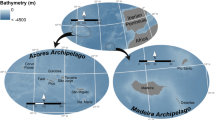Abstract
Analysis of the evolution, distribution and ecology of marine prosobranchs of the genera Neptunea and Littorina and amphipods of the genera Anisogammarus and Gammarus demonstrates the possibilities of ecological and palacoecological methods in composing evolutionary reconstructions. A comparative study of historical climate changes and of palaeogeography in areas inhabited by certain taxonomic groups, coupled with information on the distribution and ecology of species belonging to these groups, allows us to determine the time and locality of the origin of diverse biogeographical groups of species and to trace the routes of their further distribution, even in those organisms which have no fossil remains. Species dwelling under conditions which correspond historically to the most ancient climate of their dwelling area prove to be more primitive than species dwelling under newly-formed climatic conditions. For instance, subtropical species of the genera under consideration, in the Northwestern parts of the Pacific and Atlantic Oceans, have proved to be more ancient and primitive than species inhabiting the upper boreal Pacific and Atlantic waters and the Arctic Ocean. Therefore, the palaeoecological analysis of the historical development of faunas from different regions of the globe, combined with the application of the morphological principle, can significantly contribute to a more detailed and precise understanding of the processes and trends of evolution which compose the phylogenetic schemes of the taxonomic groups under discussion.
Similar content being viewed by others
Literature cited
Berg, L. S.: Climate and life, [In Russ.]. 356 pp. Moscow: Geographgiz 1947.
Bruks, K.: Climates of the past, [In Russ.]. 356 pp. Moscow: Izdatelstvo Inostrannaja Literatura 1952.
Coan, E.: Recognition of an Eastern Pacific Macoma in the coralline crag of England and its biogeographic significance. Veliger 11 (3), 277–279 (1969).
Gekker, R. F.: Introduction to palaeoecology, [In Russ.]. 126 pp. Moscow: Gosgeoltechnizdat 1957.
Golikov, A. N.: The distribution and variability of Neptunea despecta (Linné) as an indicator of the regime of the sea. [In Russ.]. Zool. Zh. 39 (10), 1485–1488 (1960).
—: Gastropods of the genus Neptunea Bolten. [In Russ.]. Fauna SSSR 1, 1–217 (1963).
—: Evolution of gastropods of the genus Neptunea Bolten. In Problems of theoretical and practical malacology, [In Russ.]. pp 109–128. Moscow-Leningrad: Izd. Akademii Nauk SSSR 1964.
—: Distribution and variability of long-lived benthic animals as indicators of currents and hydrological conditions. Sarsia 34, 199–208 (1968).
Grant, U. S. and H. R. Gale: Catalogue of the marine Pliocene and Pleistocene Mollusca of California and adjacent regions. Mem. S Diego Soc. nat. Hist. 1, 1–1036 (1931).
Hennig, W.: Gundzüge einer Theorie der phylogenetischen Systematik, 367 pp. Berlin: Deutscher Zentralverlag 1950.
Hutchins, L. W.: The bases for temperature zonation in geographical distribution. Ecol. Monogr. 17, 325–335 (1947)
Kinne, O.: The effects of temperature and salinity on marine and brackish water animals. I. Temperature. Oceanogr. mar. Biol. A. Rev. 1, 301–340 (1963).
—: Temperature: animals—invertebrates. In: Marine ecology, Vol. 1, Environmental factors, Pt. 1. pp 407–514. Ed. by O. Kinne. London: Wiley 1970.
Krishtophovich, A. N.: Geological review of the Far East countries, [In Russ.]. 332 pp. Leningrad-Moscow: Nautschno-technitscheskoje geologo-razved. izdat. 1932.
Lindberg, G. W.: The Qurternary period in the light of biogeographical data, [In Russ.]. 335 pp. Moscow-Leningrad: Izd. Akademii Nauk SSSR 1955.
—: Important planetary fluctuations of sea-level and paleogeography in the Quaternary period. In: Principal problems of study of the Quaternary period. VII. Congress of INQUA (USA). [In Russ.]. pp 135–142. Moscow: Nauka 1965.
MacNeil, F. S.: Evolution and distribution of the genus Mya, and tertiary migrations of Mollusca. Prof. Pap. U.S. geol. Surv. 483, 1–51 (1965).
Markov, K. K.: Palaeogeography, [In Russ.]. 268 pp. Moscow: Moscow University 1960.
Orton, J. H.: Sea temperature, breeding and distribution in marine animals. J. mar. biol. Ass. U.K. 12, 339–366 (1920).
Ruchin, L. B.: Climates of the past. [In Russ.]. Byull. geogr. Inst. 87 (2), 106–119 (1955).
Runnström, S.: Über die Thermopathie der Fortpflanzung und Entwicklung mariner Tiere in Beziehung zu ihrer geographischen Verbreitung. Bergens Mus. Årb. (naturvid.) 2, 1–67 (1927).
—: Weitere Studien über die Temperaturanpassung der Fort-pflanzung und Entwicklung mariner Tiere. Bergens Mus. Årb. (naturvid.) 10, 1–54 (1929).
Schwarzbach, M.: Das Klima der Vorzeit, [In Russ.]. 284 pp. Moscow: Izdatelstvo Inostrannaya Literatura 1955.
Sinitzin, V. M.: Ancient climates of Eurasia, Part 1. Palaeogene and Neogene, [In Russ.]. 167 pp. Leningrad: Leningrad University 1965.
—: Ancient climates of Enrasia, Part 2. Mesosoi, [In Russ.]. 167 pp. Leningrad: Leningrad University 1966.
Sket, B.: Zur Systematik und Phylogenie der Gammarini (Amphipoda). Bull. sci. Cons. Acad. Sci. Arts RSFY 16 (1–2), 6–7 (1971).
Smith, J. P.: Periodic migration between the Asiatic and American coasts of the Pacific Ocean. Am. J. Sci. 4 (7), 217–233 (1904).
—: Climatic relations of the Tertiary and Quarternary faunas of the Californian region. Proc. Calif. Acad. Sci. (Ser. 4) 9 (4), 123–173 (1919).
Tzvetkova, N. L.: On the parallelism of evolution, distribution and ecology of the genera Gammarus, Marinogammarus, and Anisogammarus (Amphipoda, Gammaridae). In: Reports of the scientific session of the Zoological Institute on results of researches in 1968. Theses of Reports. [In Russ.]. pp 4–5. Leningrad: Izdatelstvo Nauka 1969.
Tzvetkova, N. L.: On the system of the genera Gammarus and Anisogammarus and a new species of gammarids (Amphipoda, Gammaridae) from the north-western part of the Pacific Ocean. [In Russ.]. Trud y zoolog. Inst. Leningrad 51 (In press).
Tzvetkova, N. L. The amphipods of the genera Gammarus, Marinogammarus, Anisogammarus and Mesogammarus (Amphipoda, Gammaridae) from north and far-eastern seas of USSR and neighbouring regions. [In Russ.]. 422 pp. (Unpublished manuscript).
Vavilov, N. I.: The law of homologous series in variations. J. genet. 20 (1), 47–89 (1922).
Author information
Authors and Affiliations
Additional information
Communicated by M. E. Vinogradov, Moscow
Rights and permissions
About this article
Cite this article
Golikov, A.N., Tzvetkova, N.L. The ecological principle of evolutionary reconstruction as illustrated by marine animals. Mar. Biol. 14, 1–9 (1972). https://doi.org/10.1007/BF00365774
Accepted:
Issue Date:
DOI: https://doi.org/10.1007/BF00365774




